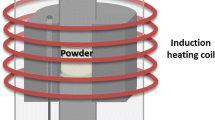Abstract
The current trend to replace cobalt in diamond cutting tools (DCTs) for stone cutting has motivated the study of alternative materials for this end. The present study evaluated the performance of several diamond-reinforced copper–nickel composites as regard to their suitability for serving as stone cutting materials. Cobalt (Co) and copper–nickel composites (Cu–Ni; Cu–Ni–10Sn, Cu–Ni–15Sn, Cu–Ni–Sn–2WC, and Cu–Ni–Sn–10WC) reinforced with 4 wt% of diamond particles were produced by hot pressing, at a temperature of 850 °C during 15 min and under an applied pressure of 50 MPa. The obtained specimens were characterized in terms of Vickers hardness and shear strength. The microstructure was analyzed by the means of SEM/EDS. A pin-on-disc wear test, with the composite serving as pin and a stone serving as disc, was performed in order to assess the tribological properties and cutting performance. Cu–Ni–Sn–10WC showed to be the material with the best cutting properties, with the highest disc/pin wear ratio registered among the remaining competing materials. This material arises as a promising alternative to be used in the stone cutting industry.
Similar content being viewed by others
References
de Oliveira LJ, Bobrovnitchii GS, Filgueira M (2007) Processing and characterization of impregnated diamond cutting tools using a ferrous metal matrix. Int J Refract Met Hard Mater 25:328–335. doi:10.1016/j.ijrmhm.2006.08.006
Yamaguchi K, Takakura N, Imatani S (1997) Compaction and sintering characteristics of composite metal powders. J Mater Process Technol 63:364–369. doi:10.1016/S0924-0136(96)02648-9
Boland JN, Li XS (2010) Microstructural characterisation and wear behaviour of diamond composite materials. Materials (Basel) 3:1390–1419. doi:10.3390/ma3021390
Dhokey NB, Utpat K, Gosavi A, Dhoka P (2013) Hot-press sintering temperature response of diamond cutting tools and its correlation with wear mechanism. Int J Refract Met Hard Mater 36:289–293. doi:10.1016/j.ijrmhm.2012.10.008
Henriques B, Soares D, Silva FS (2012a) Microstructure, hardness, corrosion resistance and porcelain shear bond strength comparison between cast and hot pressed CoCrMo alloy for metal-ceramic dental restorations. J Mech Behav Biomed Mater 12:83–92. doi:10.1016/j.jmbbm.2012.03.015
Henriques B, Gasik M, Souza JCM et al (2014) Mechanical and thermal properties of hot pressed CoCrMo-porcelain composites developed for prosthetic dentistry. J Mech Behav Biomed Mater 30:103–110. doi:10.1016/j.jmbbm.2013.10.023
Miranda G, Carvalho O, Silva F, Soares D (2013) Effect of sintering stage in NiTi short-fibre-reinforced aluminium-silicon composites interface properties. J Compos Mater 47:1625–1631. doi:10.1177/0021998312449893
Henriques B, Miranda G, Gasik M et al (2015a) Finite element analysis of the residual thermal stresses on functionally gradated dental restorations. J Mech Behav Biomed Mater 50:123–130. doi:10.1016/j.jmbbm.2015.06.003
Henriques B, Gasik M, Miranda G et al (2015b) Improving the functional design of dental restorations by adding a composite interlayer in the multilayer system: multi-aspect analysis. Cienc e Tecnol dos Mater 27:36–40. doi:10.1016/j.ctmat.2015.06.002
Konstanty J (2005) Powder metallurgy diamond tools. Powder Metall Diam Tools. doi:10.1016/B978-185617440-4/50080-8
del Villar M, Muro P, Sánchez JM et al (2001) Consolidation of diamond tools using Cu-Co-Fe based alloys as metallic binders. Powder Met 44:82–90. doi:10.1179/003258901666211
Cabral, S.C.; Filgueira M (2010) Mecanismo de Desgaste em Matriz Ferrítica com Adição de Diamantes. 2:1–8
de Paula Barbosa A, Bobrovnitchii GS, ALD S et al (2010) Structure, microstructure and mechanical properties of PM Fe-Cu-Co alloys. Mater Des 31:522–526. doi:10.1016/j.matdes.2009.07.027
Nitkiewicz Z, Swierzy M (2006) Tin influence on diamond-metal matrix hot pressed tools for stone cutting. J Mater Process Technol 175:306–315. doi:10.1016/j.jmatprotec.2005.04.056
Tillmann W, Kronholz C, Ferreira M, et al (2010) Comparison of different metal matrix systems for diamond tools fabricated by new current induced short-time sintering processes. Proceeding Powder Metall. 2010 World Congr
Henriques B, Soares D, Silva FS (2011) Shear bond strength of a hot pressed Au-Pd-Pt alloy-porcelain dental composite. J Mech Behav Biomed Mater 4:1718–1726. doi:10.1016/j.jmbbm.2011.05.029
Henriques B, Soares D, Silva FS (2012b) Influence of preoxidation cycle on the bond strength of CoCrMoSi-porcelain dental composites. Mater Sci Eng C 32:2374–2380. doi:10.1016/j.msec.2012.07.010
Borowiecka-Jamrozek J (2013) Engineering structure and properties of materials used as a matrix in diamond impregnated tools/Kształtowanie Struktury I Własnosci Materiałów Stosowanych Jako Osnowa W Narzedziach Metaliczno-Diamentowych. Arch Metall Mater 58:5–8. doi:10.2478/v10172-012-0142-0
Callister W, Rethwisch D (2007) Materials science and engineering: an introduction. Mater Sci Eng. doi:10.1016/0025-5416(87)90343-0
Mészáros M, Vadasdi K (1996) Process and equipment for electrochemical etching of diamond-containing Co-WC tools and recovery of diamond from used steel tools. Int J Refract Met Hard Mater 14:229–234. doi:10.1016/0263-4368(95)00024-0
Chen X (2009) Machining dynamics in grinding processes. In: Cheng K (ed) Mach. Dyn. Fundam. Appl. Pract. Springer London, pp 232–262
Yan J, Murakami Y, Davim J (2009) Tool design, tool wear and tool life. In: Cheng K (ed) Mach. Dyn. Fundam. Appl. Pract. Springer London, pp 116–149
Tönshoff HK, Hillmann-Apmann H, Asche J (2002) Diamond tools in stone and civil engineering industry: cutting principles, wear and applications. Diam Relat Mater 11:736–741. doi:10.1016/S0925-9635(01)00561-1
Wright DN, Wapler H, Tönshoff HK (1986) Investigations and prediction of diamond wear when sawing. CIRP Ann-Manuf Technol 35:239–244. doi:10.1016/S0007-8506(07)61879-4
Author information
Authors and Affiliations
Corresponding author
Rights and permissions
About this article
Cite this article
Henriques, B., Ferreira, P., Buciumeanu, M. et al. Copper–nickel-based diamond cutting tools: stone cutting evaluation. Int J Adv Manuf Technol 92, 1339–1348 (2017). https://doi.org/10.1007/s00170-017-0220-6
Received:
Accepted:
Published:
Issue Date:
DOI: https://doi.org/10.1007/s00170-017-0220-6




